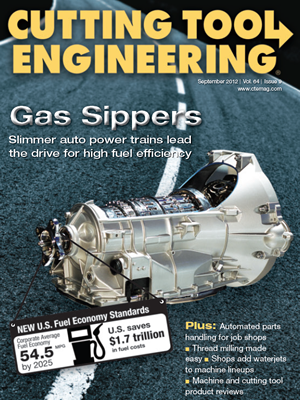Multiple-start, or multiple-groove, threads are used for getting a high lead per revolution with a shallow thread depth. The following is an example of cutting them on a manual lathe.
Suppose you have a 0.25 ipr lead, but are cutting a small-diameter cylinder or a thin-walled tube. The usual double depth, a term that describes the thread’s diameter vs. its radial depth, for a 0.25 "-lead, 60° thread is 0.324 ". If you wanted to cut this on a 0.375 "-dia. shaft, you’d be pretty much out of luck. Enter the multiple-start thread.

Courtesy of All images: T. Lipton
Be sure to confirm the gearbox settings when cutting a multiple-start thread.
As the name implies, there are more starts, or grooves, than the usual single-start thread. These threads can be identified by looking at the end of the thread and counting the number of entry starts. There is no practical limit to the number of starts you could do. The limitations typically are with the machinery used to produce them. For instance, most engine lathes will not cut threads coarser than 2 tpi.
For my example, the process is the same as cutting the usual 60° threads, with a few exceptions.
For multiple-start threads, you must index or adjust the starting position for each separate start. This can be done several ways. One is to radially index the part precisely the number of desired starts. So if you have a three-start thread, you would index each start 120°. Or, if you wanted a four-start thread, you would index the part 90°. It’s important to note that the axial, or Z-axis, position cannot change when you use the part-index method. This limits you to threading the part between centers to maintain the same Z position.
The part-index method is easier than the radial-index method but only if your lathe has a compound rest attachment that will swing 90° to be aligned with the lathe bed.
The first step is to prepare your threading blank. In the example, the diameter is arbitrary. You will cut a four-start thread with a lead of 0.25 ipr. To determine the actual thread dimensions to cut the thread, divide the 0.25 " lead by the number of starts (0.24/4 = 0.0625). This corresponds to a thread with a lead of 1⁄16 ipr, or 16 tpi. This is the thread depth for each of the four starts.
Make sure your threading levers are set to the desired lead, which is 0.25 ipr, or 4 tpi, in this example. Also, make sure the compound is set at 90° and the dial is zeroed out.

The first groove, or start, is cut at the final depth.

The second groove is cut at the final depth.

The third groove is cut at the final depth.

The fourth groove is cut at the final depth.
Out of habit, I always take a 0.001 " scratch pass to confirm my gearbox settings for each groove. You would be surprised how many times this gets fouled up. For high-lead threads, you will want to run the spindle slowly, especially if you are heading toward a shoulder as in this example.
I always use the same number on the thread dial for multiple-start threads. It is most likely OK to use other lines or numbers, but who wants to screw up their work? Typically, threading is one of the last operations performed on a part, so you have invested some time to get this far.
After cutting the first groove to final depth, you must move the compound rest a distance along the Z-axis that is equal to the thread lead divided by the number of starts (0.25/4 = 0.0625). So, advance the compound 0.0625 " to cut the second groove. The direction you move the compound does not matter as long as you don’t change that direction.
After completing each of the first three grooves, advance the compound the distance of the lead divided by the number of starts along the Z-axis. After cutting the fourth groove, it looks like a funny 16-tpi part, with the lead angle appearing much steeper than a common 16-tpi thread.
The process is fundamentally the same for an internal thread. When you make the mating female thread for this example, it will have a lead of 0.25 ipr but a thread depth of 16 tpi. Pretty cool! CTE
Related Glossary Terms
- centers
centers
Cone-shaped pins that support a workpiece by one or two ends during machining. The centers fit into holes drilled in the workpiece ends. Centers that turn with the workpiece are called “live” centers; those that do not are called “dead” centers.
- lathe
lathe
Turning machine capable of sawing, milling, grinding, gear-cutting, drilling, reaming, boring, threading, facing, chamfering, grooving, knurling, spinning, parting, necking, taper-cutting, and cam- and eccentric-cutting, as well as step- and straight-turning. Comes in a variety of forms, ranging from manual to semiautomatic to fully automatic, with major types being engine lathes, turning and contouring lathes, turret lathes and numerical-control lathes. The engine lathe consists of a headstock and spindle, tailstock, bed, carriage (complete with apron) and cross slides. Features include gear- (speed) and feed-selector levers, toolpost, compound rest, lead screw and reversing lead screw, threading dial and rapid-traverse lever. Special lathe types include through-the-spindle, camshaft and crankshaft, brake drum and rotor, spinning and gun-barrel machines. Toolroom and bench lathes are used for precision work; the former for tool-and-die work and similar tasks, the latter for small workpieces (instruments, watches), normally without a power feed. Models are typically designated according to their “swing,” or the largest-diameter workpiece that can be rotated; bed length, or the distance between centers; and horsepower generated. See turning machine.
- lead angle
lead angle
Angle between the side-cutting edge and the projected side of the tool shank or holder, which leads the cutting tool into the workpiece.
- threading
threading
Process of both external (e.g., thread milling) and internal (e.g., tapping, thread milling) cutting, turning and rolling of threads into particular material. Standardized specifications are available to determine the desired results of the threading process. Numerous thread-series designations are written for specific applications. Threading often is performed on a lathe. Specifications such as thread height are critical in determining the strength of the threads. The material used is taken into consideration in determining the expected results of any particular application for that threaded piece. In external threading, a calculated depth is required as well as a particular angle to the cut. To perform internal threading, the exact diameter to bore the hole is critical before threading. The threads are distinguished from one another by the amount of tolerance and/or allowance that is specified. See turning.


